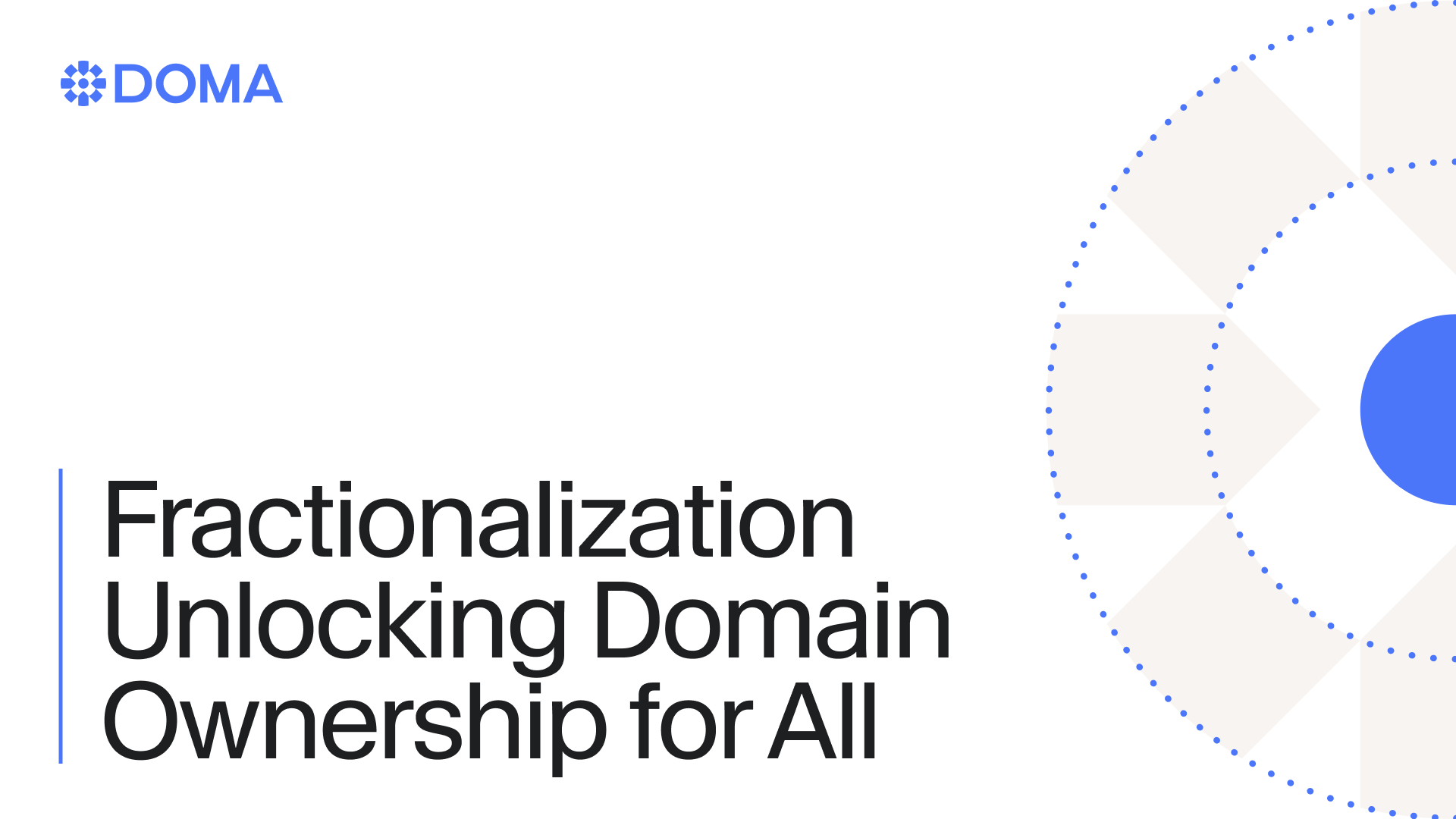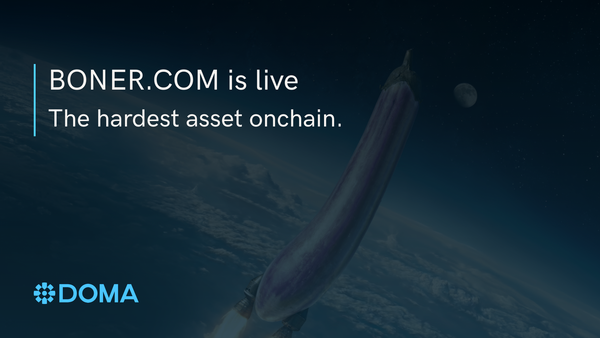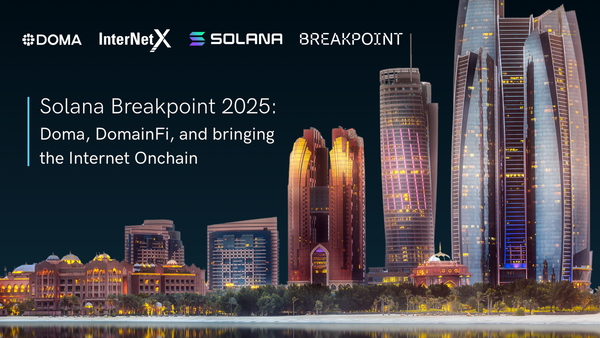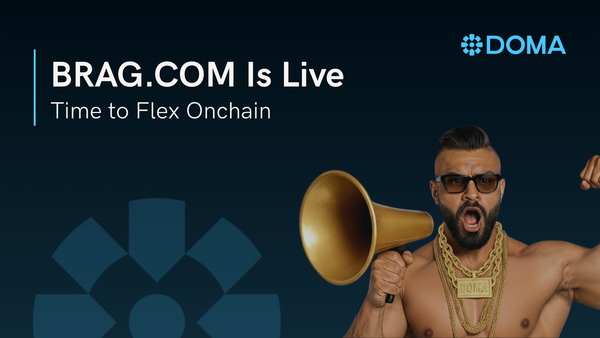Fractionalization: Unlocking Domain Ownership for All

In Part 1, we explored the why behind domain fractionalization, specifically, the benefits and motivations. In Part 2 let’s shift our focus from theory to mechanics and show how Doma actually fractionalizes domains.
Fractionalization in Doma
Doma Fractionalization allows domain NFTs to be split into fungible ERC-20 tokens. The process is executed entirely onchain via smart contracts deployed on the Doma Protocol.
Step #1: Fractionalize the Domain
The domain owner initiates the fractionalization process by interacting with the “Doma Fractionalization” contract. This triggers a series of actions:
- The original Domain Ownership Token (NFT) is securely locked.
- A new ERC-20 Fractional Token is minted, representing ownership shares of the domain.
- The tokens are automatically transferred to a Doma-approved launchpad for distribution.
- The owner can also set a Minimum Buyout Price (MBP), establishing a price floor.
Step #2: Bridge and Trade
Once minted, Fractional Tokens can be:
- Bridged to other chains like Base or Solana
- Traded on decentralized exchanges (DEXs) that support the bridged token
Step #3: Buyout the Domain
Any user can initiate a buyout by paying the greater of:
- The MBP, or
- The Fully Diluted Market Cap, calculated from live DEX pricing
Once the buyout is complete, the domain NFT is reassigned to the buyer under standard Doma ownership rules.
Step #4: Redeem Tokens Post-Buyout
After a buyout, the original fractional tokens no longer represent ownership but still hold value. Holders can:
- Redeem their tokens for Bridged USDC, proportionate to their share of the buyout price
- Or trade remaining tokens on exchanges (until burned via redemption)
This step mostly makes sure that token holders capture fair value even after ownership shifts.
Step #5 Price Discovery
All pricing is driven by DEX activity. The Doma Fractionalization contract pulls real-time token prices from integrated DEXs.
Other Approaches Are Available
It is very important to note that the process described above isn’t set in stone. The current Doma implementation serves as a general-purpose strategy, optimized for liquidity and opportunistic value capture. But it’s just one of many possible models.
After all, fractionalization isn’t a one-size-fits-all model. Different users come with different goals - some may want broader onchain ownership, while some may want partial exits with retained control.
That’s why Doma is building a modular fractionalization stack, flexible enough to support your exact requirements.
The Smart Contracts Powering Doma Fractionalization
At the heart of Doma’s fractionalization system is a specialized contract designed for secure, verifiable, and programmable ownership splits of tokenized domains. This contract handles the full lifecycle, from minting fractional tokens to enabling a buyout and final settlement, while integrating with approved launchpads and liquidity venues.
Here’s how it works:
1. Fractionalizing a Domain NFT
The process begins when the owner of a Domain Ownership Token (NFT) calls:
function fractionalizeOwnershipToken(
uint256 tokenId,
FractionalTokenInfo memory fractionalTokenInfo,
uint256 minimumBuyoutPrice
) external
struct FractionalTokenInfo {
string name;
string symbol;
}
What it does:
- The NFT is locked in the contract for custody.
- A set of fractional tokens is minted according to the total supply and token metadata specified by the owner.
- Tokens are sent to a Doma-approved launchpad in a single transaction.
- The launchpad handles fundraising and listing on supported DEXs.
- A small portion of the supply is retained by the contract as a protocol fee.
Owners can also set a minimum buyout price (MBP) in USDC to protect against undervaluation.
Why it matters:
This is where the “one asset, many owners” model begins. The fractional tokens represent proportional claims on the underlying domain.
2. Buying Out the Domain
Even after fractionalization, the underlying domain NFT can be bought out in full.
The buyout price is calculated as:
Where:
- MBP = Minimum Buyout Price set during fractionalization
- FDMC = Fully Diluted Market Cap (Total Supply × Token Price)
If the buyer is not the original NFT owner, the Doma Protocol updates on-chain ownership records accordingly.
Once bought out, the fractional tokens no longer represent domain ownership, but they still retain redeemable value.
If someone wants to take full control of the domain, they can call:
buyoutOwnershipToken(uint256 tokenId)
What it does:
- Allows a user to pay the full buyout price in USDC.
- Transfers the domain NFT to the buyer.
- Triggers settlement so that fractional holders can later redeem their share.
3. Exchanging Fractional Tokens for USDC
When a buyout occurs, holders of the original fractional tokens can redeem them for USDC, calculated as:
Once a buyout happens, fractional token holders can claim their payout via:
exchangeFractionalToken(address fractionalToken, uint256 amount)
Tokens can still be traded on exchanges post-buyout until redemption.
What it does:
- Burns the holder’s fractional tokens.
- Pays out the equivalent amount in USDC based on the buyout price.
4. Checking the Current Buyout Price
Potential buyers can query:
getOwnershipTokenBuyoutPrice(uint256 tokenId)
What it does:
- Returns the live buyout price in USDC. This is critical for market participants tracking acquisition opportunities.
5. On-Chain Transparency via Events
Doma’s contracts emit non-standard events in addition to ERC-20/ERC-721 logs, making it easy for explorers, dApps, and analytics tools to track:
- NameTokenFractionalized: When a domain NFT is fractionalized.
- NameTokenBoughtOut: When a domain is fully bought out.
These events include granular data like token addresses, buyout prices, and versioning, ensuring every step of the lifecycle is auditable.
Why This Matters
By encoding the rules of fractionalization directly into smart contracts, Doma guarantees:
- Trustless execution: No reliance on intermediaries.
- Immutable records: Every action is permanently logged on-chain.
- Programmable flexibility: The same core protocol supports multiple ownership and liquidity models.
What About Reconstitution?
Reconstitution is the process of buying out all fractional holders and restoring full ownership. It is a key part of the general Doma fractionalization lifecycle we described above. The model supports reconstitution via buyouts and USDC redemptions.
In the next post in this series, we’ll go deeper into how it works across and what it means for liquidity, governance, and asset control.




